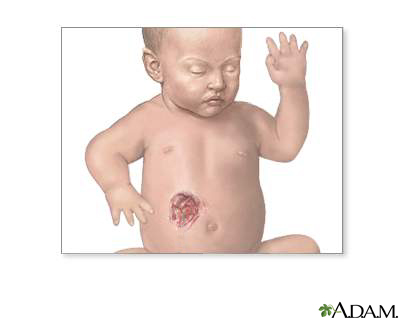Pregnancy SmartSiteTM
Infantile hemangioma; Cavernous hemangioma; Strawberry nevus; Birthmark - hemangioma DefinitionA hemangioma is an abnormal buildup of blood vessels in the skin or internal organs. CausesAbout one third of hemangiomas are present at birth. The rest appear in the first several months of life. The hemangioma may be:
SymptomsSymptoms of a hemangioma are:
Most hemangiomas are on the head, neck, or extremities. Exams and TestsThe health care provider will do a physical exam to diagnose a hemangioma. If the buildup of blood vessels is deep inside the body, a CT or MRI scan may be needed. A hemangioma may occur with other rare conditions. Other tests to check for related problems may be done. TreatmentThe majority of small or uncomplicated hemangiomas may not need treatment. They often go away on their own and the appearance of the skin returns to normal. Sometimes, a laser may be used to remove the small blood vessels. Taking beta-blocker medicines may also help reduce the size of a hemangioma. Cavernous hemangiomas that involve the eyelid and block vision can be treated with lasers or steroid injections to shrink them. This allows vision to develop normally. Large cavernous hemangiomas or mixed hemangiomas may be treated with steroids, taken by mouth or injected into the hemangioma. Outlook (Prognosis)Small superficial hemangiomas will often disappear on their own. About one half go away by age 5, and almost all disappear by age 7. Possible ComplicationsThese complications can occur from a hemangioma:
When to Contact a Medical ProfessionalAll birthmarks, including hemangiomas, should be evaluated by your provider during a regular exam. Hemangiomas of the eyelid that may cause problems with vision must be treated soon after birth. Hemangiomas that interfere with eating or breathing also need to be treated early. Contact your provider if a hemangioma is bleeding or develops a sore. PreventionThere is no known way to prevent hemangiomas. ReferencesDinulos JGH. Vascular tumors and malformations. In: Dinulos JGH, ed. Habif's Clinical Dermatology. 7th ed. Philadelphia, PA: Elsevier; 2021:chap 23. Martin KL. Vascular disorders. In: Kliegman RM, St. Geme JW, Blum NJ, Shah SS, Tasker RC, Wilson KM, eds. Nelson Textbook of Pediatrics. 21st ed. Philadelphia, PA: Elsevier; 2020:chap 669. Patterson JW. Vascular tumors. In: Patterson JW, ed. Weedon's Skin Pathology. 5th ed. Philadelphia, PA: Elsevier Limited; 2021:chap 39. | |
| |
Review Date: 11/30/2022 Reviewed By: Ramin Fathi, MD, FAAD, Director, Phoenix Surgical Dermatology Group, Phoenix, AZ. Also reviewed by David C. Dugdale, MD, Medical Director, Brenda Conaway, Editorial Director, and the A.D.A.M. Editorial team. The information provided herein should not be used during any medical emergency or for the diagnosis or treatment of any medical condition. A licensed medical professional should be consulted for diagnosis and treatment of any and all medical conditions. Links to other sites are provided for information only -- they do not constitute endorsements of those other sites. No warranty of any kind, either expressed or implied, is made as to the accuracy, reliability, timeliness, or correctness of any translations made by a third-party service of the information provided herein into any other language. © 1997- A.D.A.M., a business unit of Ebix, Inc. Any duplication or distribution of the information contained herein is strictly prohibited. | |

 Hemangioma - angio...
Hemangioma - angio... Hemangioma on the ...
Hemangioma on the ... Hemangioma excisio
Hemangioma excisio
